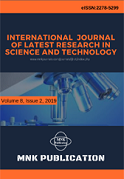DOI:10.29111/ijlrst ISRA Impact Factor:3.35, Peer-reviewed, Open-access Journal
Research Paper Open Access
International Journal of Latest Research in Science and Technology Vol.7 Issue 3, pp 1-9,Year 2018
Received : 27 April 2018; Accepted : 17 May 2018 ; Published : 27 June 2018

| Download | 125 |
|---|---|
| View | 191 |
| Article No. | 10938 |
Money laundering (ML) is one of the main issues today, because it has a great impact on the economy and society of the countries. This crime is carried out by criminal organizations that need to hide the origin of illicit money obtained from their activities, and this is achieved by disguising illicit money transactions through banks. In Mexico, in the year 2015 ten thousand millions of dollars were washed, for this reason an expert system was created, in this paper presents how the structure of the proposed expert system works, and that its main function is the evaluation of clients' transactions by an algorithm with a decision tree approach and based on rules to identify if their transactions are suspicious.
Copyright © 2018 Juan Francisco Sabas González et al. This is an open access article distributed under the Creative Commons Attribution 4.0 International (CC BY 4.0) license which permits unrestricted use, distribution, and reproduction in any medium, provided the original work is properly cited.
Juan Francisco Sabas González,Tonáhtiu Arturo RamÃrez Romero ,Miguel Patiño Ortiz , " Expert System For The Detection Of Suspicious Banking Transactions Of Money Laundering ", International Journal of Latest Research in Science and Technology . Vol. 7, Issue 3, pp 1-9 , 2018

MNK Publication was founded in 2012 to upholder revolutionary ideas that would advance the research and practice of business and management. Today, we comply with to advance fresh thinking in latest scientific fields where we think we can make a real difference and growth now also including medical and social care, education,management and engineering.

We offers several opportunities for partnership and tie-up with individual, corporate and organizational level. We are working on the open access platform. Editors, authors, readers, librarians and conference organizer can work together. We are giving open opportunities to all. Our team is always willing to work and collaborate to promote open access publication.

Our Journals provide one of the strongest International open access platform for research communities. Our conference proceeding services provide conference organizers a privileged platform for publishing extended conference papers as journal publications. It is deliberated to disseminate scientific research and to establish long term International collaborations and partnerships with academic communities and conference organizers.